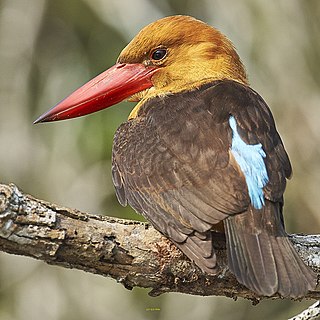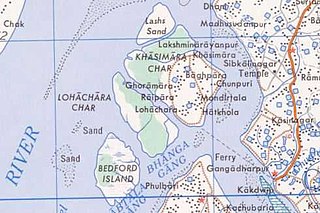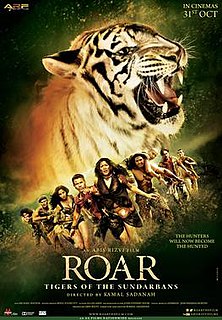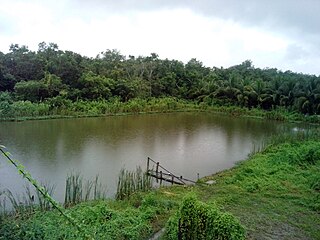 W
WThe Sundarbans is a mangrove area in the delta formed by the confluence of the Ganges, Brahmaputra and Meghna Rivers in the Bay of Bengal. It spans from the Hooghly River in India's state of West Bengal to the Baleswar River in Bangladesh. It comprises closed and open mangrove forests, agriculturally used land, mudflats and barren land, and is intersected by multiple tidal streams and channels. Four protected areas in the Sundarbans are enlisted as UNESCO World Heritage Sites, viz. Sundarbans National Park, Sundarbans West, Sundarbans South and Sundarbans East Wildlife Sanctuaries. Despite these protections, the Indian Sundarbans were considered endangered in a 2020 assessment under the IUCN Red List of Ecosystems framework.
 W
WThe Sundarbans is a mangrove area in the delta formed by the confluence of the Ganges, Brahmaputra and Meghna Rivers in the Bay of Bengal. It spans from the Hooghly River in India's state of West Bengal to the Baleswar River in Bangladesh. It comprises closed and open mangrove forests, agriculturally used land, mudflats and barren land, and is intersected by multiple tidal streams and channels. Four protected areas in the Sundarbans are enlisted as UNESCO World Heritage Sites, viz. Sundarbans National Park, Sundarbans West, Sundarbans South and Sundarbans East Wildlife Sanctuaries. Despite these protections, the Indian Sundarbans were considered endangered in a 2020 assessment under the IUCN Red List of Ecosystems framework.
 W
WBackergunge, Backergunje, Bakarganj, or Bakerganj was a former district of British India. It was the southernmost district of the Dacca Division. The district was located in the swampy lowlands of the vast delta of the Ganges and the Brahmaputra rivers.
 W
WBakkhali is a village within the jurisdiction of the Namkhana police station in the Namkhana CD block in the Kakdwip subdivision of the South 24 Parganas district in the Indian state of West Bengal.
 W
WThe Baleshwari River is located in Bangladesh, forming part of the eastern border of Bagerhat District and the western border of Barguna District. It borders on the east the largest mangrove forest in the world, in the Ganges-Brahmaputra delta, the Bangladesh part of which is set aside as the Sundarbans Reserve Forest. The Baleshwar River flows south into the Haringhata River, which flows into the Bay of Bengal.
 W
WBidyadhari River, is a river in the Indian state of West Bengal. It originates near Haringhata in Nadia district and then flows through Deganga, Habra and Barasat areas of North 24 Parganas before joining the Raimangal River in the Sundarbans.
 W
WBanbibi, the lady of the forest, also Bandevi, Bandurga and Byaghradevi is a guardian spirit of the forests venerated by both the Hindu and the Muslim residents of the Sundarbans. She is called upon mostly by the honey-collectors and the woodcutters before entering the forest for protection against the attacks from the tigers. It is believed that the demon king, Dakkhin Rai, an arch-enemy of Banbibi actually appears in the disguise of a tiger and attacks human beings.
 W
WDakshin Ray is a revered deity in the Sundarbans in India and Bangladesh who rules over beasts and demons. He is regarded as the overall ruler of the Sundarbans. The God is worshiped by all those who enter the Sunderban forests of West Bengal, for subsistence, irrespective of their caste, creed or religion.
 W
WThe Irrawaddy dolphin is a euryhaline species of oceanic dolphin found in discontinuous subpopulations near sea coasts and in estuaries and rivers in parts of the Bay of Bengal and Southeast Asia.
 W
WThe Ganges Delta is a river delta in the Bengal region of the Indian subcontinent, consisting of Bangladesh and the Indian state of West Bengal. It is the world's largest river delta and it empties into the Bay of Bengal with the combined waters of several river systems, mainly those of the Brahmaputra river and the Ganges river. It is also one of the most fertile regions in the world, thus earning the nickname the Green Delta. The delta stretches from the Hooghly River east as far as the Meghna River.
 W
WGazi Pir was a Bengali Muslim pir (saint) who lived in the 12th or 13th century during the spread of Islam in Bengal. He was known for his power over dangerous animals and controlling the natural elements. As the new local Muslim population of southern Bengal were settling in the dense forests of the Ganges delta, these were important qualities. His life is shown on the "Gazi Scroll", a scroll with 54 paintings from circa 1800, which is currently in the British Museum in London, England.
 W
WHeritiera fomes is a species of mangrove tree in the family Malvaceae. Its common names include sunder, sundri, jekanazo and pinlekanazo. It is the dominant mangrove tree species of the Sundarbans of Bangladesh and India, and comprises about 70% of the trees in the area. H. fomes is a major timber-producing tree. It is threatened by over-harvesting, water diversions in the Ganges Basin, fluctuations in salinity due to upstream and coastal development and top dying disease. The International Union for Conservation of Nature has assessed it as being "endangered".
 W
WThe Hooghly River or the Bhāgirathi-Hooghly, originally and in local tongues the 'Ganga', and also called Kati-Ganga, is an approximately 260-kilometre-long (160 mi) distributary of the Ganges River in West Bengal, India. The Ganges splits into the Padma and the Hooghly near Giria, Murshidabad. Today there is a further man-made bifurcation of the river upstream at Farakka. The Padma flows eastward into Bangladesh, whereas the Hooghly flows south through West Bengal. The river flows through the Rarh region, the lower deltaic districts of West Bengal, and eventually into the Bay of Bengal. The upper riparian zone of the river is called Bhagirathi while the lower riparian zone is called Hooghly. Major rivers that drain into the Bhagirathi-Hooghly include Mayurakshi, Jalangi, Ajay, Damodar, Rupnarayan and Haldi rivers other than the Ganges. Kolkata and Hugli-Chinsura, the headquarters of Hooghly (district), are located on the banks of this river.
 W
WThe brown-winged kingfisher is a species of bird in the subfamily Halcyoninae.
 W
WLohachara Island was an islet which was permanently flooded in the 1980s. It was located in the Hooghly River as part of the Sundarban delta in the Sundarban National Park, located near the Indian state of West Bengal. The definite disappearance of the island was reported by Indian researchers in December 2006, which led to international press coverage. No specific study was ever done to prove that the island was permanently inundated because of sea level rise.
 W
WMarichjhanpi is an island set in the mangrove forests of the Sundarbans in West Bengal, India. It is mostly remembered today for the incident in 1979 when the newly elected Communist Party of India (Marxist) government of West Bengal forcibly evicted thousands of Bengali refugees who had occupied the reserved forest land on the island. The government's actions resulted in the deaths of many refugees; although the exact number is unknown, researchers believe that at least several hundred people died from police brutality, disease and starvation. The Marichjhanpi massacre forms the backdrop of Amitav Ghosh's novel, The Hungry Tide.
 W
WMatla River forms a wide estuary in and around the Sundarbans in South 24 Parganas district in the Indian state of West Bengal.
 W
WThe 2014 Sundarbans oil spill was an oil spill that occurred on 9 December 2014 at the Shela River in Sundarbans, Bangladesh, a UNESCO World Heritage site. The spill occurred when an oil-tanker named Southern Star VII, carrying 350,000 litres of furnace oil, was in collision with a cargo vessel and sank in the river. By December 17, the oil had spread over a 350 km2 (140 sq mi) area. The oil spread to a second river and a network of canals in Sundarbans, which blackened the shoreline. The spill threatened trees, plankton, and vast populations of small fish and dolphins. The spill occurred at a protected mangrove area, home to rare Irrawaddy and Ganges dolphins. By 12 January 2015, 70,000 litres of oil had been cleaned up by local residents, the Bangladesh Navy, and the government of Bangladesh.
 W
WThe Pasur River is a river in southwestern Bangladesh and a distributary of the Ganges. It continues the Rupsa River. All its distributaries are tidal. It meets the Shibsa River within the Sundarbans, and near to the sea the river becomes the Kunga River. It is the deepest river in Bangladesh.
 W
WRoar is a 2014 Hindi-language Indian animal horror feature film written and directed by Kamal Sadanah.
 W
WSagar Island is an island in the Ganges delta, lying on the Continental Shelf of Bay of Bengal about 100 km south of Kolkata. This island forms the Sagar CD Block in Kakdwip subdivision of South 24 Parganas district in the Indian State of West Bengal. Although Sagar Island is a part of Sundarbans, it does not have any tiger habitation or mangrove forests or small river tributaries as is characteristic of the overall Sundarban delta. This island, also known as Gangasagar or Sagardwip, is a place of Hindu pilgrimage. Every year on the day of Makar Sankranti, hundreds of thousands of Hindus gather to take a holy dip at the confluence of river Ganges and Bay of Bengal and offer prayers (puja) in the Kapil Muni Temple. Kolkata Port Trust has a pilot station and a light house.
 W
WSajnakhali Wildlife Sanctuary is a 362 km2 area in the northern part of the Sundarbans delta in South 24 Parganas district, West Bengal, India. The area is mainly mangrove scrub, forest and swamp. It was set up as a sanctuary in 1976. It is home to a rich population of different species of wildlife, such as water fowl, heron, pelican, spotted deer, rhesus macaques, wild boar, tigers, water monitor lizards, fishing cats, otters, Olive ridley turtle, crocodiles, Batagur terrapins, and migratory birds.
 W
WSundarbans East Wildlife Sanctuary, a protected forest in Bangladesh, extends over an area of 31,227 ha. of mangrove forest. It was established in 1977 under the Bangladesh Wildlife (Preservation) (Amendment) Act, 1974, having previously been a forest reserve. It is the most fertile of the three, non-adjoining wildlife sanctuaries established in the Sundarbans at that time, the others being the Sundarbans West Wildlife Sanctuary and the Sundarbans South Wildlife Sanctuary. The dominant mangrove species is "sundri" from which the Sundarbans region gets its name.
 W
WThe Sundarbans National Park is a national park, tiger reserve, and biosphere reserve in West Bengal, India. It is part of the Sundarbans on the Ganges Delta, and adjacent to the Sundarban Reserve Forest in Bangladesh. The delta is densely covered by mangrove forests, and is one of the largest reserves for the Bengal tiger. It is also home to a variety of bird, reptile and invertebrate species, including the salt-water crocodile. The present Sundarban National Park was declared as the core area of Sundarban Tiger Reserve in 1973 and a wildlife sanctuary in 1977. On 4 May 1984 it was declared a national park. It is a UNESCO World Heritage Site inscribed in 1987, and it has been designated as a Ramsar site since 2019. It is considered as a World Network of Biosphere Reserve from 1989.
 W
WSundarbans South Wildlife Sanctuary is a reserve forest in Bangladesh that extends over an area of 36,970 hectares of mangrove forest. It is situated next to the Sundarbans National Park in West Bengal, India. The sanctuary is one of three Sundarbans wildlife sanctuaries, the others being the Sundarbans East Wildlife Sanctuary and the Sundarbans West Wildlife Sanctuary.
 W
WSundarbans West Wildlife Sanctuary is a UNESCO World Heritage Site and animal sanctuary in Bangladesh. The area of the reserve covers 715 km2. It is part of the larger Sundarbans region, one of the largest mangroveforests in the world. It is formed at the unified delta of the Ganges, Brahmaputra and Meghna rivers on the Bay of Bengal. The total area of the entire Sundarbans is about one million ha, 60% of which is found in Bangladesh, with the remainder in India. The region is divided by the Raimangal River. Within the Bangladeshi area of Sundarbans, there are three wildlife sanctuaries: Sundarbans East, Sundarbans South, and Sundarbans West.
 W
WTiger attacks in the Sundarbans, in India and Bangladesh are estimated to kill from 0-50 people per year. The Sundarbans is home to over 100 Bengal tigers, one of the largest single populations of tigers in one area. Before modern times, Sundarbans were said to "regularly kill fifty or sixty people a year".
 W
WThe Bengal tiger is a tiger from a specific population of the Panthera tigris tigris subspecies that is native to the Indian subcontinent. It is threatened by poaching, loss, and fragmentation of habitat, and was estimated at comprising fewer than 2,500 wild individuals by 2011. None of the Tiger Conservation Landscapes within its range is considered large enough to support an effective population of more than 250 adult individuals. India's tiger population was estimated at 1,706–1,909 individuals in 2010. By 2018, the population had increased to an estimated 2,603–3,346 individuals. Around 300–500 tigers are estimated in Bangladesh, 220–274 tigers in Nepal and 103 tigers in Bhutan.